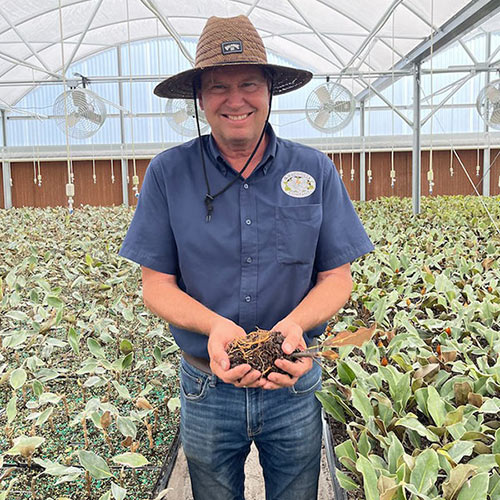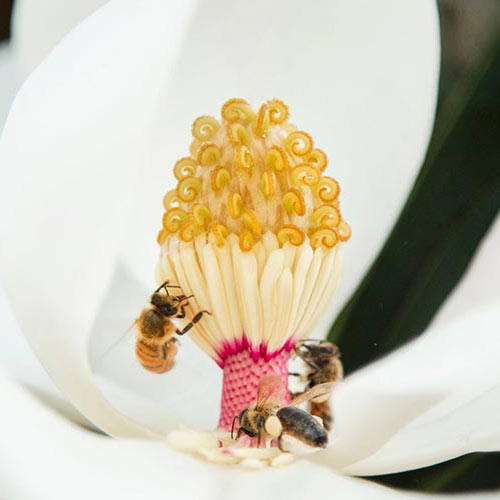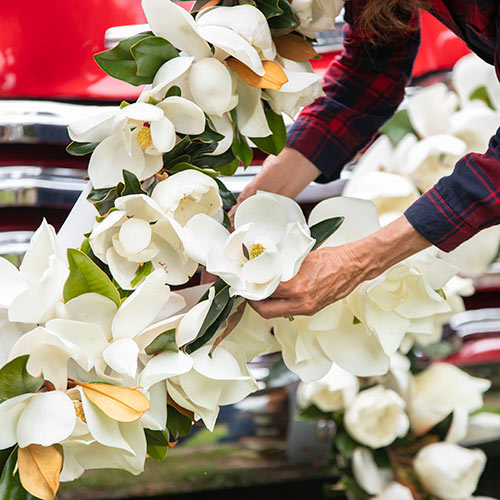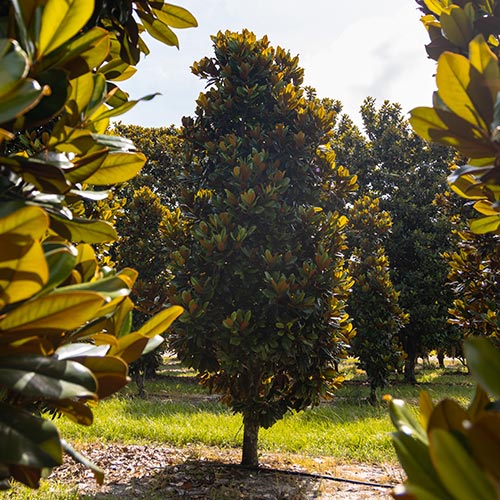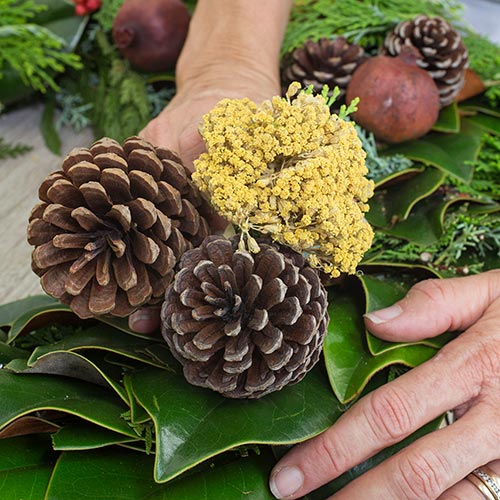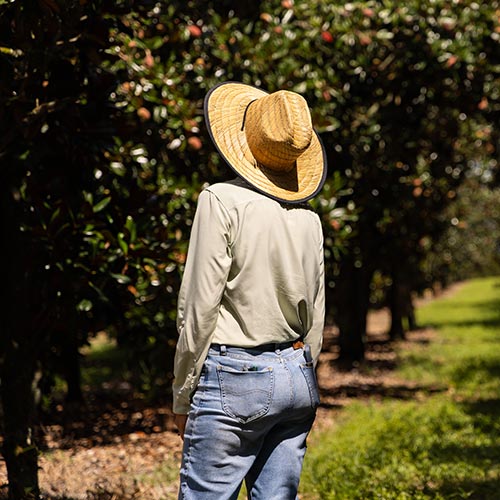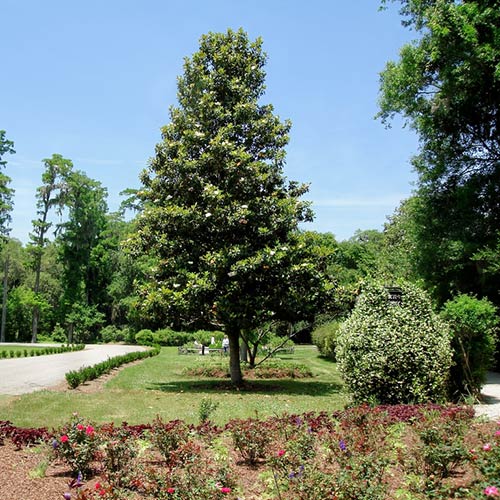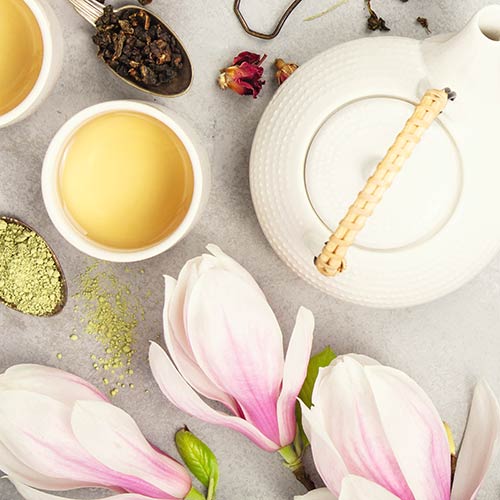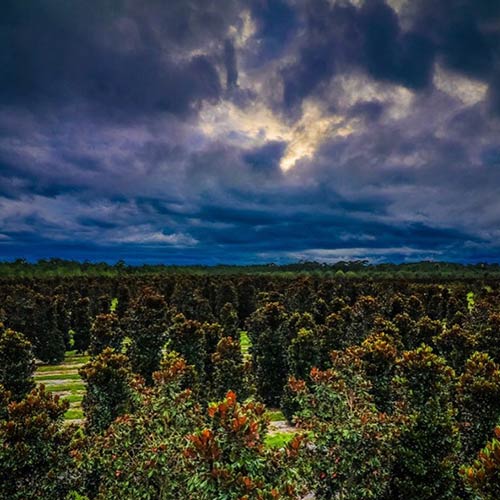From the Flower: How We Distill Magnolia Essential Oil
April 7th, 2025
Waste Not, Want Not
Innovation and creativity are a huge part of running any business, but especially agribusiness. At The Magnolia Company, we’re big into using as much of the tree as we can, from root to leaf. State of the art propagation techniques, sustainable harvesting practices, and unbelievable amounts of environmental science and technology are only a fraction of what goes on behind the scenes at our family farm in Central Florida.
The healthiest magnolia foliage finds purpose in all manner of decor, all year round. Boughs of magnolia become propagations for future rooted trees that make their way to your yard. Magnolia pods allow us to plant more from what we have. Even the natural debris from our groves (old leaves, fallen branches, healthy pruned clippings) become natural compost for the farm. Nothing goes to waste – not even a drop of water, thanks to our water reclaiming system.
But, we haven’t discussed one of the biggest draws to the beloved Southern Magnolia: their blossoms.
Magnolia blossoms are beloved natural decor across the country and beyond. From bridal bouquets to yard statements that announce the arrival of summer, the large, sweet, creamy flowers produced by Southern Magnolias are symbols of nobility and purity.
When Life Gives You Magnolia Blooms…

You know the saying “when life gives you lemons, make lemonade?” It’s an old (and occasionally frustrating) adage about making the best of a sour circumstance.
But what do you do when life gives you something beautiful?
Magnolia blooms are the most fragile part of the tree. Unlike magnolia leaves and wood, which are both reliably durable, the blossoms are effervescent. They appear seasonally, closing at night and opening at dawn (it’s a pollination thing). The flowers only stay on the branch short term before falling from the tree, having fulfilled their purpose.
With delicate white petals in most species, the flowers are extremely sensitive to temperature, as well as the presence of dirt and oils. Once harvested, the blooms need to be kept refrigerated or they’ll wilt and be brown by the end of the day.
If, for instance, you create a bouquet using magnolias, you must be very careful not to touch the petals. The natural oils from your hands will cause them to turn brown even faster than exposure to heat. For this reason, it’s uncommon for florists to work with this flower, despite its renowned scent and beauty.
So what can you do with a magnolia flower?
Lots! But we’ve opted for a very specific use: distillation.
Its organic form might be temporary, but the chemicals released by the magnolia flower are less so. In fact, you can distill magnolia flowers into their natural oils, and then use the oils to make other creations.
The Magnolia Company has a smaller subcategory of products. We call the line “Mary’s Magnolias,” and the creations are top of the line bath & body products (think soaps and lotions).
Rare Magnolia Essential Oil (Sort Of)
Allow us to nerd all over you for a minute…
There are 3 terms you need to understand in order for this process to make sense:
1. Distillation
Distillation is a process that allows you to separate the liquid chemical compounds of a mixture using pressure and steam.
You know those cheesy sci-fi movie mad scientist laboratory setups? The bubbling beakers that have complex tubing and ultimately just drip a couple drops of prized liquid into a vial? That’s the process we’re talking about, and yes, the technology does look a little wild!
2. Essential Oil
Essential Oils are highly concentrated, volatile, aromatic extracts that come from plants. In layman’s terms, they’re nature’s perfume oil, and because they’re natural, they degrade over time. They’re also really not safe or good for your skin, due to their potency.
Perfumes and products that use essential oils are often paired with what’s called a carrier oil, which is a neutral oil that helps dilute the concentration of the essential oil without interfering with the fragrance. The carrier oil is what makes essential oils safe for skin and cosmetic use. It also helps stabilize the essential oil, so it’s less prone to evaporation or deterioration.
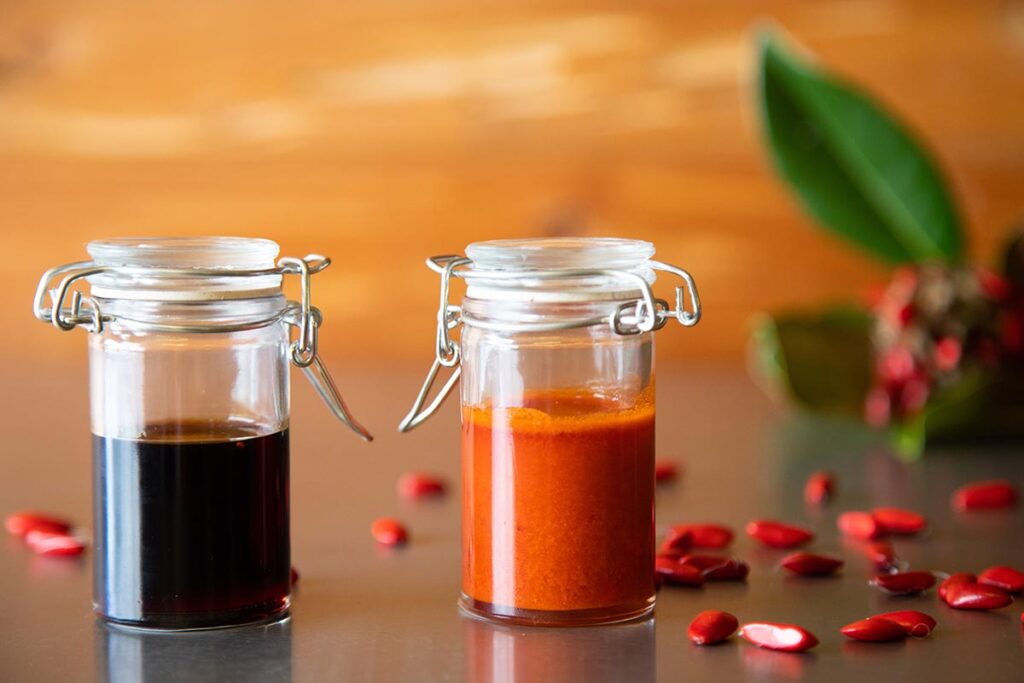
3. Hydrosol
Hydrosol is the purest essence of the plant material, containing the plant’s natural alcohols, acids, tannins, and trace amounts of essential oil. Distillation produces hydrosol. Because of this natural chemical balance, hydrosol is safe to use directly on skin without assistance from carrier oils. It works like a toner, refreshing, brightening, and cleansing your skin with a gentle natural fragrance.
Hydrosol is often incorrectly termed “floral water.” While you often find both hydrosol and essential oil as ingredients in floral water, and floral water has a similar cosmetic function as hydrosol, floral water is not synonymous with hydrosol.
Distilling Magnolias
We begin the process by selecting a block of trees in our field that have a lot of blossoms, specifically in April. The harvesting process continues through May.
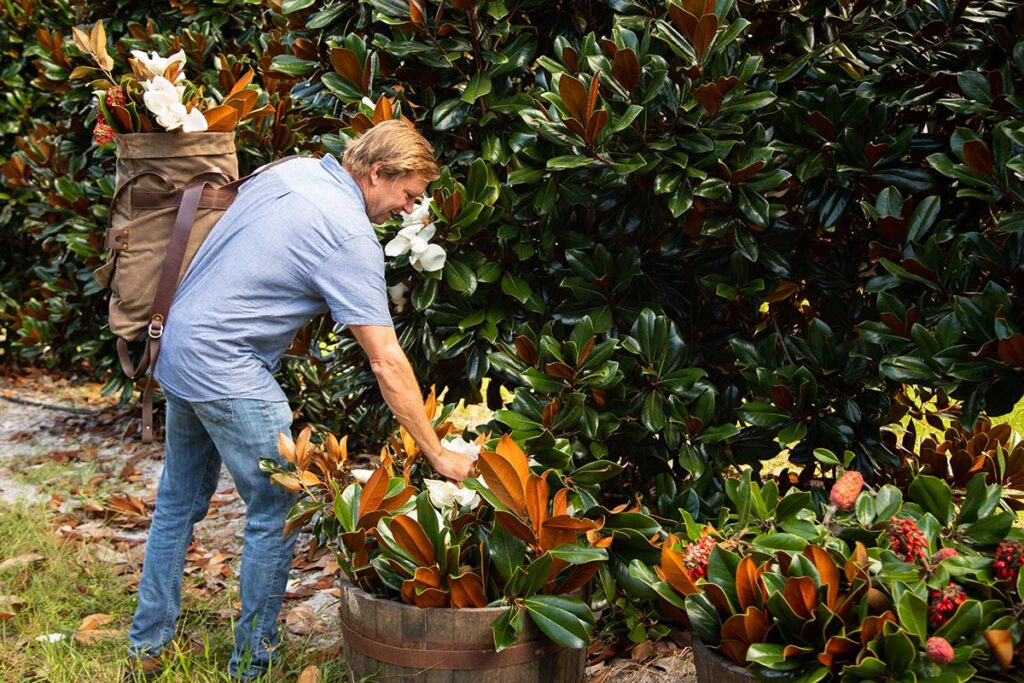
The name of the game is efficiency. As we mentioned, magnolias are delicate flowers. We have to work quickly to maintain the highest quality. Bright and early at 7:30 in the morning, we’re out in the fields harvesting flowers. This is when they have the most fragrance oil available. It’s beautiful, in the quiet of the morning amid the hum of the bees.
Oftentimes, the dew hasn’t yet had an opportunity to evaporate off of the flowers. Of course, if there are bees gathered in a flower, we leave the flower be. They need the flowers more than we do, after all!
In a single morning, we’ll harvest 500-750 flowers. We don’t want to stress the trees or interrupt the pollination process any more than we have to. Our team loads the flowers into large coolers, and we bring the coolers to our distillation area where the still is set up.
As quickly as we can, we pack the flowers into the still, about 200 at a time, then tighten down the lid and reduce the pressure inside the still. We add heat by boiling water in the bottom of the still, which creates steam that moves through the baskets of flowers.
The steam carries the flowers’ essence through the still, and it condenses in a copper tube. Copper is an excellent conductor, so it releases and absorbs heat very easily. The copper tube winds through a cooling coil, and the transfer of heat cools the steam back down to drops of liquid, called condensate.
As the condensate flows through the cool tubing, it gets deposited into sterile containers. We seal the full containers and store them in a cooler facility. After about a month, the solid oils float to the top and become skimmable from the liquid below. We set those essential oils to the side for later use! It’s not much, making magnolia essential oil quite rare.
What we’re really after is what’s under the essential oil: the hydrosol. It’s got loads of unique properties.
One of our company owners, Julie Roth, spritzes her face in the mornings with magnolia hydrosol as a facial toner (just like witch hazel). It’s a really clean, pure smell that’s great for her (and your) skin!
Because the process yields more hydrosol than oil, and because hydrosol is safe for skin on its own, it’s one of the largest ingredients in our soaps and lotions. It lasts a very long time because it’s both sterile and naturally antimicrobial.
We meant what we said: no leaf, no branch, and no petal goes to waste at The Magnolia Company!
What do you think? Would you try a magnolia soap, toner, or lotion?
Recent Articles

